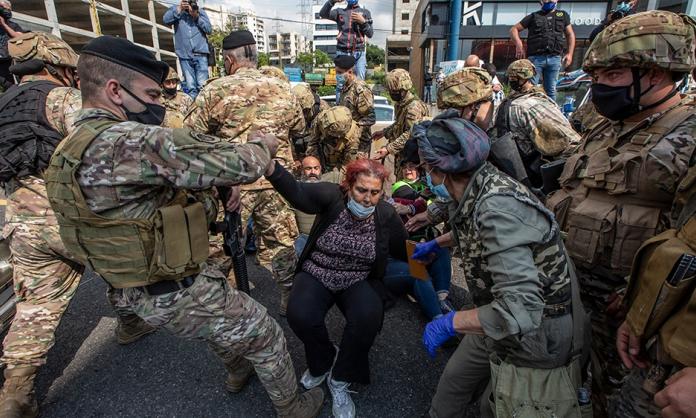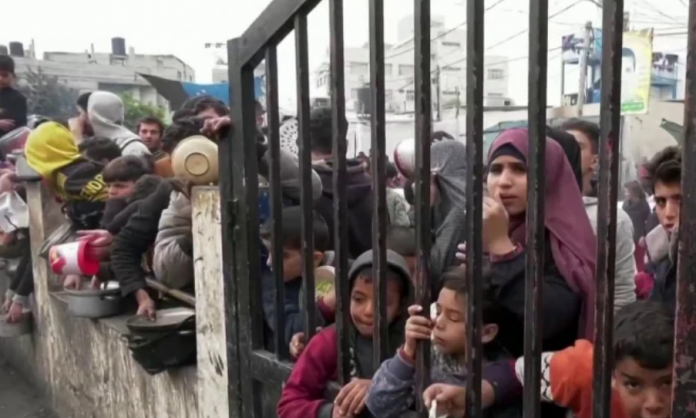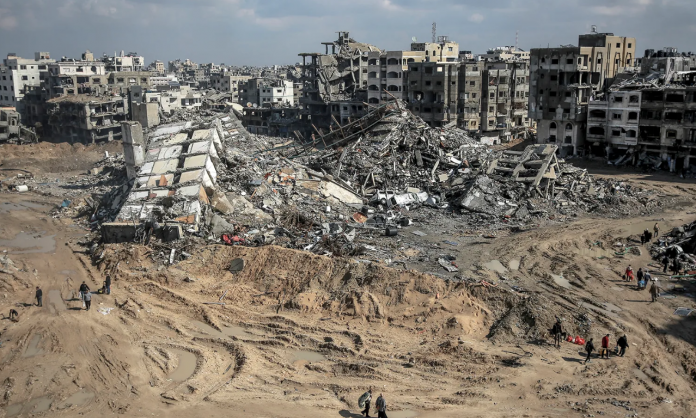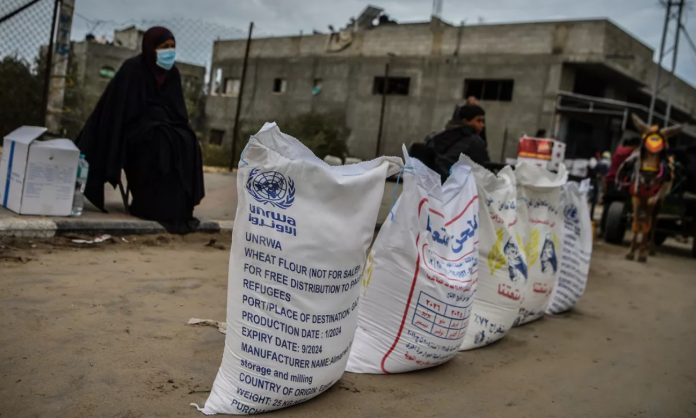Last year, Lebanon’s October 17 revolution hit the country like a wave of hope for the hopeless. Less than a year later, months of turbulence, instability, economic despair, and a pandemic seemingly signified an end to the country’s revolutionary upheaval. The meagre resources and infrastructure of the grassroots movement seemed too frail to cope.
Nevertheless, Lebanon’s working class is gradually escaping the lockdown and protesting for survival in the crisis. They’re taking vengeance on the banking sector and asserting a moral commitment to progressive struggle in face of the constant attempts at co-optation strategies imposed by different sectors of the elite.
Right now, marginalised groups are facing hyperinflation, currency devaluation, and the resulting reductions in purchasing power. But many of today’s hardships stem from fiscal and monetary policies implemented in the past few decades.
Before delving into the second wave of anti-bank riots emerging since late April, it’s crucial to highlight some of the rhetorical conflicts between a variety of elite institutions and players: the current technocratic neoliberal government, “traditional” players, and the banking sector.
Lebanon’s technocratic government, headed by Prime Minister Hassan Diab, gained power in late January of this year. This primarily took place as the cabinet was given the confidence of the country’s pro-Hezbollah parliamentary bloc. Initially, the government focused on an ideologically hollow “good governance” discourse: “combating corruption”, “reforming” the public sector, and tackling patronage.
Gradually, with the decision to default a $1.2 billion Eurobond payment meant for early March, the government’s conflict-ridden relationship with the banking sector raised questions about the direction of the government’s economic policy.
In early April, the cabinet’s economic draft plan was leaked. It claimed to radically restructure the banking sector and implement a “haircut” on bank deposits, increase indirect taxation, and implement privatisation. It hinted in the direction of an IMF-conditioned loan, and projected an alarming increase in the official exchange rate.
The cabinet, mainly formed of upper middle class academics and professionals, also has the support of Jamil El Sayyed, a current Member of Parliament and Hezbollah ally. El Sayyed is known for his brutal role as former head of General Security during Syria’s mandate in the country prior to 2005.
Accordingly, the country’s technocratic government has grown much more repressive and violent under the supervision of the Minister of Interior (also El-Sayyed’s former military colleague) Mohamad Fehmi. Even though the cabinet was vocally critical of the banking sector and the Central Bank, government security and army forces used the lockdown to enforce a wide range of brutal measures cracking down on anti-bank riots.
In this context, the “old guard” generally refers to the apparent rift created between “pro-Syria” elites and “anti-Syria” elites following the end of Syria’s occupation of Lebanon in 2005. While the former aligned with Hezbollah’s self-proclaimed “anti-US” foreign policy and right to maintain arms, the latter boasted friendly relations with the United States and a “pro-state” sovereignty discourse. These two broad factions, which each include multiple political parties, are referred to as the March 8 and March 18 blocs.
However, since the domestic power dynamics tilted in favor of Hezbollah in 2016, the “rift” between these two elite coalition virtually disappeared. Instead, a “unity” government was formed to put aside such strategic differences and maintained all sides’ right to patronage, economic monopolies, and sect-based control of their strongholds.
The new technocratic government has tried to pin responsibility for the crisis on the banking sector and preceding cabinets spearheaded by the “8-14” coalition. But this rhetoric met resistance.
The entirety of the ex-March 14 alignment (the Lebanese Forces, the Future Movement, and the Progressive Socialist Party) aggressively exploited popular frustration with the new government’s unpopular policies in an attempt to garner support for the government’s ouster.
That’s because the new government was founded on the parliamentary trust of the March 14 bloc’s rival, the pro-Hezbollah ex-March 8 political alignment. Gradually, however, Nabih Berri’s Amal Movement – a Shia political grouping that had supported the government – withdrew due to their growing fear that the influence of traditional political forces organised on religious lines might wane. That left Hezbollah and President Michel Aoun’s Free Patriotic Movement the government’s only allies.
So the ex-March 14 alignment and the Amal Movement protected the Central Bank Governor Riad Salameh from the cabinet’s “allegations”, which alluded to his unfair monetary policies. These policies are proven to have granted commercial banks one-time profits worth billions of dollars from tax payers, while amplifying the risks concerned with overall macroeconomic stability.
It’s important to note that these temporary rifts hardly ever pave the way the elite polarisation of Lebanon’s elite factions into permanently hostile blocs. For example, Hezbollah’s tacit rhetorical support for the Diab cabinet did not entail breaking away from the traditional strategic dynamics of Lebanon’s intra-elite struggle. On the 4th of May, Nasrallah implicitly hinted that his party has no plan to radically transform how things operate from within the Central Bank.
Meanwhile, PSP leader Walid Jumblatt explicitly expressed his rejection of any attempt to bring down the cabinet, instead suggesting a more negotiated process.
Despite these convoluted rhetorical attempts to co-opt the on-the-ground escalation against either the government or the Central Bank, much of Lebanon’s traditional neoliberal and sectarian forces have failed to take charge of an overwhelmingly spontaneous second wave of demonstrations.
After the cabinet released its “reform” project, and after the Central Bank circulated several notes restricting the average citizen’s dollar earnings (by automatically converting these notes to the local currency), the street grew angrier, particularly in rural areas outside of Beirut.
It’s worth noting that the lockdown, globally and locally, had harsher implications on average working-class people, especially the working class who depend on wages for their daily work.
Across the northern areas of Tripoli and Akkar, and the southern areas of Nabatieh, Tyre, and Sidon, protests erupted in violation of the general curfews enforced by the government. Unlike the beginning of the movement of October 17 2019, these protests were small at first, and targeted commercial banks and public property.
In Tripoli, the army, under the leadership of Gen. Joseph Aoun and interior minister Mohamad Fehmi, attacked the demonstrations and escalated its arrests of several protesters. An oppositional discourse highlighting the coercive and oppressive institutional reality of the army became more commonplace.
This was especially ground-breaking because Lebanon is known for its high degree of pro-army hysteria, especially regarding the so-called “Sunni Islamist” stronghold of Tripoli, one of Lebanon’s most impoverished and demonised regions. Essentialist rhetoric targeting Tripoli climaxed during ISIL’s assault on the army’s positions in the northern part of the country.
After protester Fawwaz Al-Samman was killed by a live army bullet during a clash in the region this April, activists from all over Lebanon planned a solidarity convoy towards Tripoli, where a march commenced at Nour Square and headed towards the victim’s family home.
In Sidon, the army reacted to protests by detaining several demonstrators. News leaked that the military had tortured an activist with electrocution. As the act was condemned by a wide range of activists, alternative lawyer syndicates released an unprecedented condemnation of the army’s increasingly brutal and militaristic responses to the protests.
Two days later, alarming details have surfaced about the military and police tracking activists’ homes and issuing arbitrary arrests for “inciting against the army”.
On the level of collective group involvement, the beginning of Lebanon’s second wave of protests also showed a rise in the involvement of left-wing student and youth groups, alongside the launches of a variety of online campaigns demanding tuition discounts during the pandemic and reversing any attempt to “dollarise” tuition (increasing fees due to the pegged exchange rate of the Lebanese pound).
Despite initial calls by some liberal-esque activists or Hezbollah-leaning sympathisers to openly collaborate with the neoliberal technocratic government of Hassan Diab (and by extension, the International Monetary Fund), this did not mirror a positive reaction from the vast majority of popular forces on the ground.
While the various sectors of the ruling class have attempted to co-opt demonstrations and the progressive popular demands of activists, large sections of the grassroots opposition in the country have grown accustomed to promoting a horizontalist, rejectionist attitude towards any compromise with the sectarian regime institutions.
However, a challenge remains. Can the demonstrators be organised into discrete political units with clear ideological sentiments that are able to solidify large sections of the population under a unifying political project?
In 2015, the NGOisation of social movements and de-politicisation of discourse liquidated any attempt to provide a well-specified political and economic program to steer the street. Instead, they gave rise to vague appeals to a neoliberal “good governance” rhetoric often targeting the public sector.
On one hand, the sentiments and set of demands provided in 2019 transformed the very vocabulary of the street into clear left-wing articulations and antagonisms. On the other hand, the lack of vertical organization and leadership, urgent negotiations on socio-economic grounds, and concrete political organizations hindered the movement’s ability to garner enough resources required to advance transformative institutional change.
While some have provided roadmaps for how they expect events to move forward, any analytical framing of Lebanon’s crisis and revolutionary upheaval ought to acknowledge the unexpected dynamics and opportunities provided by shaky class relations.
With the dangerously restrictive pandemic, drastic consequences for women, migrant workers, precarious youth, refugees, and the average worker have surfaced. As different actors and social groups battle over who ought to pay the price, the role of the Left (domestically and internationally) ought to be concerned with supporting the most marginalized communities in face of the new authoritarian and neoliberal realities accompanying the economic and health crises.










